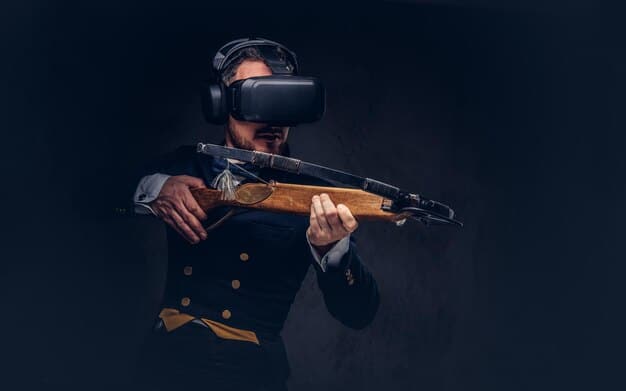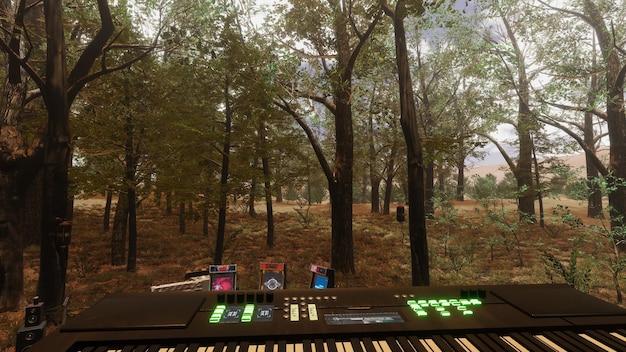Virtual Concerts: Analyzing Trends, Tech, and Their Staying Power

The Rise of Virtual Concerts: Are They Here to Stay? A Look at the Latest Trends and Technologies investigates the evolving landscape of live music, exploring how virtual concerts leverage innovative technology to offer immersive experiences and examining their potential for long-term integration into the entertainment industry.
The world of live music has been undergoing a radical transformation, and at the forefront of this evolution is the rise of virtual concerts. This article, The Rise of Virtual Concerts: Are They Here to Stay? A Look at the Latest Trends and Technologies, will delve into whether these digital performances are a fleeting trend or a glimpse into the future of entertainment.
The Digital Stage is Set: Understanding Virtual Concerts
Virtual concerts have emerged as a powerful new medium, bridging the gap between artists and fans in unprecedented ways. Let’s examine how these performances function and their unique qualities.
What Defines a Virtual Concert?
A virtual concert extends beyond a simple livestream; it is a fully immersive experience designed to replicate the energy of a live show in a digital environment.
Key Elements of a Virtual Concert Experience
From interactive elements to high-quality visuals, several components are crucial to creating an engaging virtual concert.
- Interactive Communication: Real-time chat features and Q&A sessions allow artists to interact directly with their audience.
- High-Quality Production: Advanced camera work, dynamic lighting, and professional audio mixing enhance the viewing experience.
- Virtual Environments: Digital stages and animated backdrops create unique and visually stunning settings for performances.
- Gamified Elements: Incorporating gaming features such as avatars, leaderboards, and virtual merchandise boost engagement.
The effectiveness of a virtual concert lies in its ability to provide more than just a passive viewing experience; it aims to actively involve the audience and create a sense of collective participation.
Technological Innovations Driving Virtual Concerts
The technological advancements fueling virtual concerts are rapidly expanding, redefining the possibilities for live entertainment. Let’s explore these groundbreaking innovations.

VR and AR Integration
Virtual Reality (VR) and Augmented Reality (AR) technologies play a crucial role in enhancing the immersive qualities of virtual concerts, offering unique viewing perspectives.
Advancements in Streaming Quality
Delivering high-quality video and audio is essential for an enjoyable virtual concert experience.
- 5G Technology: Provides faster and more reliable internet speeds, enabling seamless streaming and reducing latency.
- Advanced Compression Algorithms: Efficiently compress video and audio data without sacrificing quality, optimizing bandwidth usage.
- Content Delivery Networks (CDNs): Distribute content from servers located around the world, ensuring quick access and minimal buffering for viewers.
Higher streaming quality helps bridge the gap between the live performance and the digital experience, making viewers feel more connected to the event and the artist.
The Economic Impact of Virtual Concerts
The financial implications of virtual concerts are significant, creating new revenue streams for artists and reshaping the music industry. Explore how these concerts generate value.
New Revenue Streams for Artists
Virtual concerts offer a diverse range of monetization opportunities beyond traditional ticket sales.
Reshaping the Music Industry Landscape
The advent of virtual concerts is causing a ripple effect across various industry sectors.
- Reduced Reliance on Touring: Artists can generate income without the extensive costs and logistical challenges of physical tours.
- Expansion of Global Reach: Virtual concerts enable artists to connect with fans worldwide, transcending geographical barriers.
- Diversified Performance Formats: Artists can experiment with unique and innovative performance formats tailored for digital audiences.
The adaptability and scalability of virtual concerts are providing a resilient alternative to traditional live events, opening new pathways for financial sustainability and artistic innovation.
Case Studies: Successful Virtual Concerts
Studying successful virtual concerts and events shows the great potential that lies within the format. Let’s look at a few examples that have proven successful in recent times.

Analyzing High-Profile Virtual Events
Examining notable virtual concerts can offer valuable insights into what works and what doesn’t.
Best Practices from Virtual Concert Pioneers
Drawing lessons from early adopters can help artists and organizers optimize their approach.
- Focus on Engagement: Incorporate interactive elements to keep viewers actively engaged.
- Prioritize Production Quality: Ensure high-quality audio and video for an immersive viewing experience.
- Promote Exclusivity: Offer exclusive content or experiences to incentivize ticket purchases.
- Leverage Social Media: Use social media platforms to promote the event and foster community.
By learning from both successes and shortfalls, the industry can continue to refine the virtual concert experience, enhancing its appeal and effectiveness.
The Virtual Concert Audience: Who’s Tuning In?
Understanding the demographics and preferences of the virtual concert audience is essential for tailoring effective strategies. Let’s examine who is attending these events.
Understanding Audience Demographics
Analyzing the demographics of virtual concert attendees offers powerful insights.
The Appeal to Different Age Groups
Different age groups respond to virtual concerts for varying reasons.
- Gen Z and Millennials: Attracted by the convenience, accessibility, and tech-savviness of virtual concerts.
- Gen X: Appreciate the ability to enjoy live music from the comfort and safety of their homes.
- Baby Boomers: Value the opportunity to experience live performances without the challenges of attending physical events.
By understanding the diverse motivations and preferences of different demographic groups, artists and organizers can craft more compelling and inclusive virtual concert experiences.
Challenges and Future Directions
While virtual concerts have made significant strides, challenges remain. We also need to discuss the future direction of the format.
Addressing the Limitations of Virtual Concerts
Identifying and mitigating the existing limitations is crucial for the continued growth.
The Future of Virtual Concerts: What’s Next?
As technology continues to advance, what can we expect from the future of virtual concerts?
- Enhanced Immersive Experiences: Increased use of VR and AR technologies to create more realistic and engaging environments.
- Personalized Concert Experiences: AI-driven platforms that tailor the concert experience to individual viewer preferences.
- Hybrid Concert Models: Blending virtual and physical elements to create innovative and inclusive live events.
By overcoming current limitations and embracing emerging technologies, virtual concerts can continue to evolve and solidify their place in the entertainment industry.
| Key Point | Brief Description |
|---|---|
| 🎉 Immersive Experiences | VR and AR create realistic, engaging concert environments. |
| 💰 New Revenue Streams | Virtual concerts offer diverse monetization beyond tickets. |
| 📡 Tech Innovations | 5G and better compression enhance streaming quality. |
| 🌍 Global Reach | Artists connect with fans worldwide, overcoming geography. |
Frequently Asked Questions
▼
Virtual concerts offer global reach and interactive features but lack the physical presence and spontaneous energy of live events. They are accessed from home, providing convenience but a different sensory experience.
▼
Artists can monetize with ticket sales, exclusive merchandise, sponsorships, and interactive virtual experiences. Offering tiered packages, such as VIP access to virtual meet-and-greets, also boosts revenue.
▼
VR/AR enhances immersion, while 5G ensures stable, high-quality streaming. Motion capture and advanced graphics create realistic avatars and environments for more engaging performances.
▼
The audience spans various age groups. Gen Z and millennials like the tech, Gen X appreciates convenience, and baby boomers enjoy access without travel. Concerts offer something for everyone.
▼
Challenges include replicating the energy of live performances, preventing piracy, and ensuring adequate streaming quality for all viewers. Development is ongoing improve the audience experience.
Conclusion
In conclusion, virtual concerts are transforming the live entertainment industry, offering new avenues for artists and fans alike. While challenges remain, technological advancements and innovative strategies continue to enhance the virtual concert experience, suggesting they are poised for long-term integration into the music and entertainment landscape.





